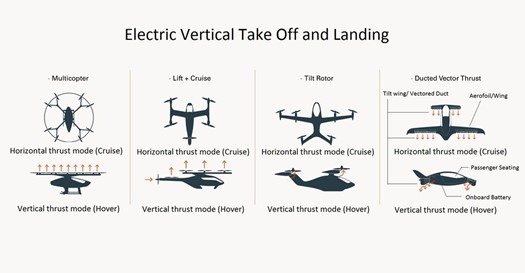We all know that air travel is the quickest and most efficient mode of transportation since it uses natural routes and does not necessitate the physical construction of additional routes. They are unaffected by obstacles such as dense forests, steep mountains, deserts, and oceans. However, looking at the existing model of transportation mediums, it has various drawbacks in addition to being the fastest and quickest type of transportation. Avionics as an industry relies heavily on fuel combustion engines that produce significant harmful gases and contribute to air pollution.
To mitigate such issues, aircraft manufacturers have spent a huge sum of money, time, and effort in developing a viable alternative solution for air transportation employing hybrid-electric or electric aircraft. After the launch of hybrid-electric or electric aircraft, the industry witnessed a massive transformation. These aircraft provide a classic and environmentally sustainable alternative to the traditional air combustion-based aviation industry. They have the potential to transform the future of elevated transportation by transporting people and freight more rapidly, silently, and affordably than the conventional approach.
eVTOL is a type of aircraft that is fueled by electric power. It can take off and land vertically. These aircraft are designed for shorter and point-to-point regional air mobility (2 to 6 pax), cargo deliveries, and military purposes. They are safe, quiet, reliable, comfortable, less expensive, and low emission form of transportation, which doesn’t require any kind of infrastructure for take-off and landing.
According to a MarketsandMarkets study, the worldwide market for eVTOL (Electric Vertical Take-off and Landing) is expected to be USD 8.5 billion in 2021 and USD 30.8 billion by 2030, growing at a 15.3 percent CAGR throughout this period.
Let’s try to understand the technology behind eVTOL.
eVTOL Technology
Lift Technology
According to the fleet of available aircraft, the market is classified into Vectored thrust, lift + cruise, Tiltrotor, and multirotor technologies.

Fuel Technology
This type of aircraft contains several components such as controllers, fuel cells, and generators. In terms of propulsion power, these aerial vehicles often use solid-state batteries or lithium-ion batteries.
Operating Technology
Evolving technology and increasing adoption of digital technologies such as the Internet of Things (IoT), Mixed Reality (Augmented + Virtual), and Artificial Intelligence (AI), have transformed the aerospace industry. Based on the aforementioned technologies, eVTOLs can be classified into three main categories:
- Autonomous
- Semi-Autonomous
- Piloted
Maximum Take-Off Weight (MTOW) and Range
Urban air mobility generally operates in the range of 5-40km at the speed of 70-120km/h and the regional air mobility that connects major metropolitan cities have a range of 100-300kms. They have a speed of above 200km/h with a cruising altitude between 1,000 to 2,000 feet.
Based on the application of the aircraft, it is divided into different segments based on their carrying weight capacity between 100-1000kg for air mobility of passengers and cargo material transportations.
- Less than 200kg – These aircraft are preferably used for cargo transportation.
- 200kg and above – These aircraft are deployed with heavy batteries and can be used in air taxis, medical assistance, personal passenger transportation, and combat missions.
Challenges with the eVTOL market
1. Infrastructure
eVTOL aircraft, like present systems, may not require a large runway or massive infrastructure like airports to function, but they do require space to land and take off, as well as passenger waiting terminals. Since these aircraft operate similar to helicopters, they may utilize the same infrastructure. However, the main issue is that the helipad or area is not equipped with charging stations to power these aircraft. With some improvements and additions to the present infrastructure, eVTOLs can be made mainstream.
2. Technology
Technology is advancing at a quick pace across the world. Several eVTOL companies are seeking to produce autonomous aircraft by exploiting the digital revolution occurring across industries. This modification is expected to lower the aircraft’s weight and allow for greater passenger room on board.
3. Standards and Regulations
eVTOL’s market share, at the moment, is a small fraction of the aerospace business, and numerous modifications may be required to make it a viable mode of transportation. eVTOL manufacturers are working hard to standardize these aircraft per the Federal Aviation Administration (FAA) and European Aviation Safety Agency (EASA) rules. The FAA has only certified a handful of eVTOLs so far.
4. Mass market/adoption
Safety has become an essential component of any type of vehicle in the market, whether it is in the automotive or aerospace industries. Because eVTOL is a relatively new idea and technology, the adoption rate is likely to be low until people become more acquainted with it.
Many eVTOL manufacturers are discussing the safety and emergency measures necessary for this type of aircraft, which include emergency concerns, fire safety, and weather precautions.
The road map for eVTOL aircraft is quite promising due to their small size, eco-friendly nature, and convenience as a means of urban and regional air travel. Along with commercial purposes, it may also be used for freight transportation, surveillance, emergency medical services (air ambulance and medical cargo transport), and mission-critical projects. To do so, it must conform to the laws and regulations specified by the FAA and EASA and be equipped with all necessary safety features.
eInfochips is a product engineering company with over 25 years of expertise in Device Engineering, Digital Engineering, Quality Engineering, and Silicon Engineering. eInfochips has extensive aerospace knowledge and end-to-end technical expertise and processes (DO-254, DO-178B, DO-178C, DO-160, and ARP-4754), as well as expertise in aircraft display systems such as Head-Up/Down Display, Integrated Flight Deck, EICAS, EFIS, and has successfully worked on multiple integrated flight deck display systems development and platform software verification. Most of the efforts comprise keeping DAL-A systems at par with the FAA and EASA requirements. We support clients with FAA certification audits (SOI-I to SOI-IV) and EASA certification audits. Additionally, we have implemented the Runway Overrun Awareness and Alerting System (ROAAS), enhancing safety and operational efficiency.
Contact our experts to find out more about how eInfochips can help the aerospace industry.













